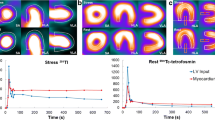Abstract.
Evaluation of myocardial perfusion in the early stage of acute myocardial infarction (MI) is clinically important for adjunctive therapies to minimize infarct size. To determine the role of early scintigraphic detection of impaired myocardial reperfusion after primary coronary angioplasty (PTCA) in patients with acute MI, semiquantitative technetium-99m tetrofosmin single-photon emission tomographic (SPET) imaging was performed before primary PTCA (before; area at risk), 60 min after PTCA (after) and at 1 month (1 M; final infarct) in 35 patients with acute MI. The left ventricle was divided into 13 segments and the defect score was calculated as the sum of the perfusion defect of each segment, from 3 (complete defect) to 0 (normal perfusion). A significant myocardial perfusion change after PTCA was defined as a change in the defect score (before minus after PTCA) of ≥4. The echocardiographic asynergic score was defined as the number of asynergic (severe hypokinetic or akinetic) segments corresponding to the analogous segments on SPET images, and recovery of wall motion was calculated as absolute change in the asynergic score (before PTCA minus 1 M). Among the 35 patients, 15 (43%) had a change in the defect score of <4 (no reflow: group 1) while 20 had a change in the defect score of ≥4 (reflow: group 2). There were no significant differences between the two groups with respect to the time between admission to PTCA, revascularization time, collateral grade or Thrombolysis in Myocardial Infarction (TIMI) flow grade before PTCA. Despite the lack of a difference in area at risk between the two groups (group 1 = 12.8±4.3 and group 2 = 15.1±4.7), final infarct size in group 1 was significantly larger compared with that in group 2 (8.1±4.3 vs 4.9±3.0, P<0.001). Recovery of wall motion was significantly smaller in group 1 than in group 2 (4.3±1.7 to 3.5±1.5 vs 4.1±2.1 to 1.6±1.6, P<0.001). In conclusion, a small change (<4) in defect score (scintigraphic no-reflow phenomenon) after primary PTCA indicates persisting impaired myocardial perfusion or irreversible cellular damage just after PTCA which is associated with poor recovery of wall motion, as compared with that observed in cases of reflow (≥4 in defect score).
Similar content being viewed by others
Author information
Authors and Affiliations
Additional information
Received 12 September and in revised form 11 November 1998
Rights and permissions
About this article
Cite this article
Hamada, S., Nakamura, S., Sugiura, T. et al. Early detection of the no-reflow phenomenon in reperfused acute myocardial infarction using technetium-99m tetrofosmin imaging. Eur J Nucl Med 26, 208–214 (1999). https://doi.org/10.1007/s002590050378
Issue Date:
DOI: https://doi.org/10.1007/s002590050378




